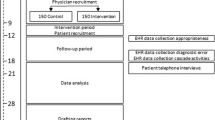Abstract
Objective:To reduce testing among bospitalized patients using practice guidelines for any of 14 medical problems.
Design:Comparison of test use before and after implementation of guidelines. The guidelines were developed by consensus panels of self-selected participating physicians. Non-participating physicians were monitored during the same periods. In addition, the two groups of physicians were evaluated similarly for their management of three medical problems for which guidelines were not developed.
Setting:Acute care hospital.
Patients/participants:1,638 hospitalized patients and their 79 physicians.
Intervention:Implementation of practice guidelines for the care of hospitalized patients.
Measurement and main results:Geometric mean charges expressed in inflation-adjusted dollars were used as measures of test use. For the intervention group, laboratory tests decreased by 20.6%, x-rays by 42.3%, and EKGs by 34.2%. All the decreases were significant (p=0.001). The non-participating physicians who were higher test users during both years of the study also achieved significant (p<0.05) but smaller reductions during the intervention year: 13.9% for laboratory tests, 30.3% for x-rays, and 21.8% for EKGs, perhaps because the same residents were involved in the care of both groups of patients. For the non-guideline diagnoses, the participating physicians achieved reductions of 11.1% for laboratory tests and 19.2% for x-rays, and a 3.5% increase in EKGs. Two-way analyses of variance that took into account the reductions in testing achieved by non-participants, or by participants with non-guideline diagnoses, revealed no significant reduction in testing attributable directly to the guidelines except for EKGs. Follow up of the participating physicians during the six months after the end of the intervention revealed that testing remained at the lower level achieved while the guidelines were in use. Outcome of care, as measured by deaths in the hospital, deaths within 90 days of discharge, and readmissions within 90 days of discharge, was not affected by the use of the guidelines.
Conclusions:1) A large group of physicians could be recruited in a hospital to establish practice guidelines by group consensus. 2) These self-selected physicians were willing to use the guidelines (or allow the bousestaff to use them) while caring for their patients. 3) Participating physicians were able to achieve substantial and significant reductions in testing without any demonstrable adverse effect on quality of care as measured by deaths and readmissions, and without any demonstrable shifting of resources from the inpatient to the outpatient setting of care. 4) The reductions in testing, whether caused by the guidelines or not, persisted for at least six months beyond the end of the period of implementation.
Similar content being viewed by others
References
Eisenberg JM, Williams SV. Cost containment and changing physicians’ practice behavior: can the fox learn to guard the chicken coop? JAMA. 1981;246:2195–201.
Thurow LC. Sounding board: learning to say “no.” N Engl J Med. 1984;311:1569–72.
Levinsky NG. Sounding board: the doctor’s master. N Engl J Med. 1984;311:1573–5.
Fuchs VR. Sounding board: the “rationing” of medical care. N Engl J Med. 1984;311:1572–3.
Kassirer JP. Sounding board: our stubborn quest for diagnostic certainty. A cause of excessive testing. N Engl J Med. 1989;320:1489–91.
Sox HC. Guidelines for medical practice: necessary but not sufficient. J Gen Intern Med. 1989;4:551–2.
Somers AR, Somers HM. A proposed framework for health and health care policies. Inquiry. 1977;14:115–70.
Berwick DM. Continuous improvement is an ideal in health care. N Engl J Med. 1989;320:53–6.
Finkler SA. The distinction between cost and charges. Ann Intern Med. 1982;96:102–9.
Hughes RA, Gertman PM, Anderson JJ, et al. The ancillary services review program in Massachusetts. JAMA. 1984;252:1727–32.
Komaroff AL, Black WL, Flatley M, Knopp RH, Reiffen B, Sherman H. Protocols for physician assistants. N Engl J Med. 1974;290:307–12.
Greenfield S, Friedland G, Scifers S, Rhodes A, Black WL, Komaroff AL. Protocol management of dysuria, urinary frequency, and vaginal discharge. Ann Intern Med. 1974;81:452–7.
Estes EH Jr, Sullivan RJ Jr. Standards for practice: effectiveness and acceptance. Ann Intern Med. 1978;89:826–8.
Grimm RH Jr, Shimoni K, Harlan WR Jr, Estes EH Jr. Evaluation of patient-care protocol use by various providers. N Engl J Med. 1975;292:507–14.
Sox HC Jr, ed. Common diagnostic tests—use and interpretation. Philadelphia: American College of Physicians, 1987.
American College of Cardiology/American Heart Association Task Force. Guidelines for ambulatory electrocardiography. JACC. 1989;13,1:249–58.
The 1988 report of the Joint National Committee on Detection, Evaluation, and Treatment of High Blood Pressure. Arch Intern Med. 1988;148:1023–38.
Report of the National Cholesterol Education Program Expert Panel on Detection, Evaluation, and Treatment of High Blood Cholesterol in Adults. Arch Intern Med. 1988;148:36–69.
Spiegel JS, Shapiro MF, Berman B, Greenfield S. Changing physician test ordering in a university hospital: an intervention of physician participation explicit criteria and feedback. Arch Intern Med. 1989;149:549–58.
Wachtel TJ, Moulton AW, Pezzullo J, Hamolsky M. Inpatient management protocols to reduce health care costs. Med Decis Making. 1986;6:101–9.
Lomas J, Anderson GM, Domnick-Pierre K, et al. Do practice guidelines guide practice? The effect of a consensus statement on the practice of physicians. N Engl J Med. 1989;321:1306–11.
Alper PR. Guidelines for common diagnostic tests and the practicing internist. J Gen Intern Med. 1989;4:548–50.
Brook RH. Practice guidelines and practicing medicine. Are they compatible? JAMA. 1989;262:3027–30.
Author information
Authors and Affiliations
Additional information
Received from the Division of General Internal Medicine, Rhode Island Hospital, Providence, Rhode Island.
Presented in part at the annual meeting of the Society of General Internal Medicine, Arlington, Virginia, April 27, 1989.
Supported by a grant from the National Fund for Medical Education.
Rights and permissions
About this article
Cite this article
Wachtel, T.J., O’Sullivan, P. Practice guidelines to reduce testing in the hospital. J Gen Intern Med 5, 335–341 (1990). https://doi.org/10.1007/BF02600402
Issue Date:
DOI: https://doi.org/10.1007/BF02600402




